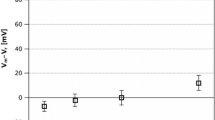Abstract
The effects of Ca2+ and vitamin E (α-tocopherol) on acetylcholine (Ach)-induced Cl− currents in LP11 and RBc4 neurons of the snail Helix pomatia have been studied. Injection of Ca2+ into the cells and application of vitamin E (10−5 mole/liter) induced the appearance of potentiation of Ach-induced currents in membrane parts more remote from the axon than the Ach-sensitive regions in the control. The Hill coefficient (n) for such Ach receptors was equal to 0.8, unlike 1.8 for Ach receptors active in the control. Arachidonic acid (10−5 mole/liter) and phorbol ester TPA (10−6 mole/liter) inhibited Ach responses, while oleoylacetyglycerol (10−6 mole/liter) produced no effect. Calmidazolium (10−6 mole/liter) decreased the effects of Ca2+ and vitamin E on Ach responses, while nordihydroquiaretic acid (5 · 10−6 mole/liter) enhanced the modulating effect of vitamin E and weakened that of arachidonic acid. It is suggested that the expression of Ach receptors activated by Ca2+ and vitamin E is mediated through posttranslational mechanisms, since cycloheximide and actinomycin D, inhibitors of protein synthesis, did not influence the effects of C2+ and vitamin E. The mechanisms responsible for the stimulating effects of Ca2+ and vitamin E are discussed.
Similar content being viewed by others
References
Yu. I. Aleksandrov and T. N. Grechenko, “Ethanol effect on electric activity of isolated neurons inHelix pomatia,”Zh. Vyssh. Nervn. Deyat.,41, No. 2, 423–426 (1991).
V. G. Gogvadze, N. N. Brustovetsky, and A. A. Zhukova, “Phospholipase A2 participation in isolation of liver mitochondria of rats induced by lipid peroxidation products,”Biokhimiya,55, No. 12, 2195–2199 (1990).
G. V. Donchenko,Biochemistry of Oubiquinone, Naukova Dumka, Kiev (1988).
V. A. Dyatlov, “Vitamin E regulation of acetyl choline receptor topography in molluscan neurons,”Dokl. Akad. Nauk SSSR,314, No. 3, 748–752 (1990).
V. A. Dyatlov and A. V. Platoshin, “Effect of calcium neurons on acetylcholine-induced current in molluscan neurons,”Neirofiziologiya,22, No. 4, 553–556 (1990).
V. A. Dyatlov, “An intensifying action of intracellular calcium ions on acetylcholine-induced current in molluscan neurons: calmodulin significance,”Biol. Membr.,8, No. 5, 522–527 (1991).
V. A. Dyatlov, P. V. Belan, E. A. Bakai, et al., “Tocopherol modulation of acetylcholine-induced current in molluscan neurons,”Neirofiziologiya,23, No. 5, 628–631 (1991).
E. M. Molochkina, N. V. Borovok, and E. B. Burlakova, “Modification of the lipid component of neuronal membranes by antioxidants as a method for controlling their functional activity,”Biol. Memb.,8, No. 11, 1146–1147 (1991).
G. V. Petrova, A. A. Kaptalov, and G. V. Donchenko, “Vitamin E effect on transcription in isolated nuclei and chromatin of the liver of rats in norm and with E-hypovitaminosis,”Biokhimiya,56, No. 11, 2052–2059 (1991).
A. S. Pivovarov, E. I. Drozdova, and B. I. Kotlyar, “Arachidonic acid and its acyclic derivatives regulate short-term plasticity ofHexlic pomatia acetylcholine-receptor neurons,”Zh. Vyssh. Nervn. Deyat.,41, No. 4, 796–805 (1991).
R. N. Skryma, F. V. Burdyga, N. B. Prevarskaya, et al., “Effect of lipoxygenase blocker BW 755C calcium currents in neuronal membrane of the small and contractile responses of smooth muscular fibers of guinea pig ureter,”Neirofiziologiya,19, No. 6, 841–844 (1987).
F. B. Adamstone, “Lymphoblastoma occurring in young chicks reared on diet treated with ferric chloride to destroy vitamin E,”Am. J. Cancer,28, No. 2, 540–546 (1963).
J.-P. Changeux, C. Pinset, and A. Ribera, “Effects of chlorpromazine and phencyclidine on mouse C2 acetylcholine receptor kinetics,”J. Physiol.,378, 497–513 (1986).
L. V. Dekker, P. N. E. De Graan, H. Spierenburg, et al., “Evidence for a relationship between B-50 (GAP-43) and [3H] noradrenaline release in rat brain synaptosomes,”Eur. J. Pharmacol. Sect. Mol. Pharmacol.,188, Nos. 1–3, 113–122 (1990).
V. A. Dyatlov, “Calcium influx in molluscan neurons enhances the acetylcholine-induced current: The role of calmodulin,”Comp. Biochem. Physiol. Ser. C,99, No. 3, 305–308 (1991).
V. A. Dyatlov, “Vitamin E regulates acetylcholine receptor function of molluscan neurons,”Comp. Biochem. Physiol. Ser. C.,100, No. 3, 665–669 (1991).
V. A. Dyatlov, “Effect of vitamin E on acetylcholine-induced current in molluscan neurons: Role of cytoplasmic free calcium and arachidonic acid,”Neuroscience,49, No. 3, 745–752 (1992).
K. Gietzen, “Comparison of the calmodulin antagonists compound 48/80 and calmidazolium,”Biochem. J.,216, No. 3, 611–616 (1983).
D. Kim, D. L. Lewis, L. Graziadei, et al., “G-protein βγ-subunits activate the cardiac muscarinic K+-channel via phospholipase A2,”Nature,337, 557–560 (1989).
D. K. Koblin and H. A. Lester, “Voltage-dependent blockade of acetylcholine receptors by local anesthetics inElectrophorus electroplaques,”Mol. Pharmacol.,15, No. 3, 559–580 (1979).
D. Piomelli, E. Shapiro, S. J. Feinmark, and J. H. Schwartz, “Metabolism of arachidonic acid in the neuron system ofAplysia,”J. Neurosci.,7, No. 11, 3675–3686 (1987).
D. Piomelli, A. Volterra, N. Dale, et al., “Lipoxygenase metabolites of arachidonic acid as second messengers for presynaptic inhibition ofAplysia sensory cells,”Nature,328, 38–43 (1987).
H. Smilowitz, R. A. Hadjian, J. Dwyer, and N. B. Einstein, “Regulation of acetylcholine receptor phosphorylation by calcium and calmodulin,”Proc. Natl. Acad. Sci. USA,78, No. 8, 4708–4712 (1981).
Y. Takai, U. Kikkawa, K. Kaibuchi, and Y. Nishizuika, “Membrane phospholipid metabolism and signal transduction for protein phosphorylation,” in:Advances in Cyclic Nucleotide and Protein Phosphorylation Research, P. Greengard, G. A. Robinson (eds.), Raven Press, New York (1984), pp. 119–158.
Author information
Authors and Affiliations
Additional information
Translated from Neirofiziologiya, Vol. 25, No. 1, pp. 31–39, January–February, 1993.
Rights and permissions
About this article
Cite this article
Dyatlov, A.V. Effects of Ca2+ and vitamin E on posttranslational regulation of acetylcholine receptor expression in the somata of identified molluscan neurons. Neurophysiology 25, 26–32 (1993). https://doi.org/10.1007/BF01053630
Received:
Issue Date:
DOI: https://doi.org/10.1007/BF01053630



